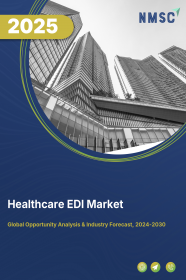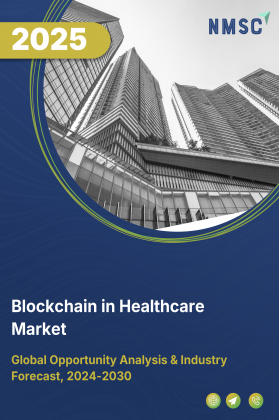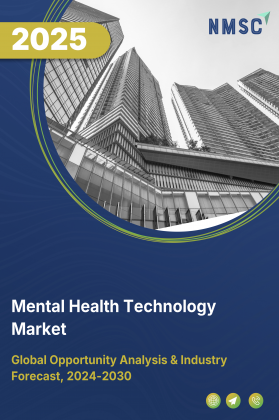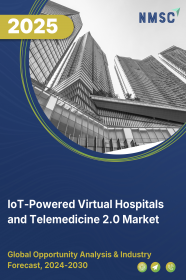
Healthcare EDI Market by Component (Services and Solutions), by Transaction Type (Claim Management, Healthcare Supply Chain, Payment Remittance, and Others), by Mode of Delivery (Web & Cloud-based EDI, EDI VAN, Point-to-Point EDI, Mobile EDI, and Others), and by End User (Healthcare Providers, Healthcare Payers, Medical Devices and Pharmaceutical Industry, and Others)– Global Opportunity Analysis and Industry and Forecast 2024-2030
Healthcare EDI Market Overview
The global Healthcare EDI Market size was valued at USD 3.79 billion in 2023 and is predicted to reach USD 7.06 billion by 2030 with a CAGR of 9.2% from 2024-2030. The healthcare EDI market encompasses the electronic exchange of healthcare information in standardized formats, including claims processing, patient records, and payment transactions. It enhances the efficiency and accuracy of data processing, reduces administrative costs, and improves the overall quality of care. It facilitates secure and swift transmission of claims, payment information, patient records, and other critical data, streamlining operations and ensuring compliance with regulations.
Market Dynamics and Trends
The rising government spendings across the globe in healthcare infrastructure drives the healthcare EDI market demand. This increasing investment enables the healthcare industry to adopt latest technologies to enhance operational efficiency, streamline administrative processes, and ultimately improve healthcare delivery outcomes.
According to a report from the Centers for Medicare & Medicaid Services (CMS), the medical spendings in the U.S rose to around USD 4.84 trillion in 2023 from USD 4.50 trillion in 2022. Also, the government of India allocated approximately USD 107.85 billion in 2023, marking an increase from USD 95.74 billion allocated in 2022. With such huge allocation of funds towards healthcare, the government aims to modernize and equip healthcare systems with the latest technologies, including digital information exchange.
Additionally, the growing telemedicine & remote monitoring facility across the globe is further driving the growth of healthcare EDI market trends. Electronic data exchange transforms healthcare delivery by supporting real-time communication and facilitating timely intervention of healthcare professionals, enhancing overall patient outcome. According to the report published by National Library of Medicine in March 2024, more than 40% of people actively use telemedicine services, resulting in improvements of patient health. As more people continue to utilize the digital healthcare facility, the adoption of EDI is poised to rise, driving the growth of the market.
However, the high cost of implementation and maintenance of advanced healthcare informatics solution among the smaller healthcare providers and organizations restrain the healthcare EDI market growth. On the contrary, the integration of the artificial intelligence (AI) in healthcare EDI is anticipated to create ample growth opportunities in the market in the coming years. AI allows healthcare systems to use predictive analytics by examining historical and real-time data to foresee potential health issues, enabling early interventions and personalized treatment plans. This enhances patient care, optimizes resource allocation, and improves health outcomes.
Market Segmentations and Scope of the Study
The healthcare EDI market report is segmented on the basis of component, transaction, mode of delivery, end user and region. On the basis of component, the market is divided into services and solutions. On the basis of transaction type, the market is classified into claim management, healthcare supply chain, payment remittance and others. On the basis of mode of delivery, the market is categorized into web & cloud-based EDI, EDI VAN, point-to-point EDI, mobile EDI and others. On the basis of end user market is bifurcated into healthcare providers, healthcare payers, medical devices and pharmaceutical industry and others. Regional breakdown and analysis of each of the aforesaid segments includes regions comprising of North America, Europe, Asia-Pacific, and RoW.
Geographical Analysis
North America dominates the healthcare EDI market share and is expected to continue its dominance during the forecast period. This is attributed to the growing adoption of cloud technology by the healthcare organizations in numerous countries including Mexico, the U.S., and Canada. For instance, in July 2022, Mexico launched the first Oracle Cloud Infrastructure (OCI) offering public & private organizations to improve customer experience and improve country's ecosystem. Such growth in the adoption of cloud technology in this region drives demand for healthcare EDI systems to efficiently manage various operations while also safeguarding sensitive data.
Also, presence of major key players such as McKesson Corporation, Optum Inc. and GE Healthcare that are adopting various collaboration that boost the market growth in this region. For instance, in April 2022, GE Healthcare announced collaboration with Medtronic to meet growing need for outpatient care. This collaboration facilitated customers to access financial solutions, exceptional service, and digital solutions by using EDI services, enhancing operational efficiency, workflow and clinical outcomes.
On the other hand, Asia-Pacific is expected to show a steady rise in the global market. This is due to the rising adoption of digital healthcare systems, driven by the rising government initiatives, is propelling the growth of the market in the Asia-Pacific region. For instance, the government of India launched digital health-service initiatives such as e-Sanjeevani and e-Hospital, while China introduced Internet Plus healthcare in recent years. These initiatives aim to promote the adoption of online healthcare services in the region, thereby driving the healthcare EDI market expansion.
Moreover, the rapid growth of the insurance industry in countries such as India, China, and Japan are significantly driving the adoption of Electronic Data Interchange (EDI) to enhance operational efficiency. As stated by the Ministry of Commerce and Industry, India's life insurance sector is expanding at an impressive rate of 32-34% annually, with foreign direct investment reaching USD 6.5 billion over the past decade. This growth necessitates efficient data management, making EDI essential for automating transactions, reducing errors, and streamlining processes such as claims processing and eligibility verification.
Competitive Landscape
The healthcare EDI industry comprises of various market players such as Allscripts Healthcare Solutions Inc., GE Healthcare, Cognizant, McKesson Corporation, Optum Inc., SSI Group Inc., Experian Plc, Synnex Corporation, Quadax Inc. and Siemens Healthineers AG among others. These market players are adopting various joint ventures and collaboration of business across various regions to maintain their dominance in the market.
For instance, in June 2023, Cognizant and ServiceNow announced a strategic partnership aimed at advancing end-to-end digital transformation through AI-driven automation. Through this launch, the companies aim to accelerate the adoption of solutions that enhance operational efficiency in areas such as electronic data interchange.
Moreover, in April 2022, Optum Inc. announced to extend their merger agreement with Change Healthcare. This merger was aimed towards simplifying the core clinical, administrative and payment processes with the help of EDI. Moreover, in March 2022, Cognizant announced a collaboration with Microsoft to offer new virtual healthcare solution. This collaboration offers a new digital health solution to enhance remote patient monitoring for improved patient well-being.
Key Benefits
-
The report provides quantitative analysis and estimations of the market from 2024 to 2034, which assists in identifying the prevailing market opportunities.
-
The study comprises a deep-dive analysis of the current and future healthcare EDI market trends to depict prevalent investment pockets in the market.
-
Information related to key drivers, restraints, and opportunities and their impact on the market is provided in the report.
-
Competitive analysis of the players, along with their market share is provided in the report.
-
SWOT analysis and Porters Five Forces model is elaborated in the study.
-
Value chain analysis in the market study provides a clear picture of roles of stakeholders.
Healthcare EDI Market Key Segments
By Component
-
Services
-
Solutions
By Transaction Type
-
Claim Management
-
Healthcare Supply chain
-
Payment Remittance
-
Others
By Mode of Delivery
-
Web & Cloud-based EDI
-
EDI VAN
-
Point-to-Point EDI
-
Mobile EDI
-
Others
By End User
-
Healthcare Providers
-
Healthcare Payers
-
Medical Devices and Pharmaceutical Industry
-
Others
By Region
-
North America
-
The U.S.
-
Canada
-
Mexico
-
-
Europe
-
The UK
-
Germany
-
France
-
Italy
-
Spain
-
Denmark
-
Netherlands
-
Finland
-
Sweden
-
Norway
-
Russia
-
Rest of Europe
-
-
Asia-Pacific
-
China
-
Japan
-
India
-
South Korea
-
Australia
-
Indonesia
-
Singapore
-
Taiwan
-
Thailand
-
Rest of Asia Pacific
-
-
RoW
-
Latin America
-
Middle East
-
Africa
-
Key Players
-
Allscripts Healthcare Solutions Inc.
-
GE Healthcare
-
Cognizant
-
McKesson Corporation
-
Optum Inc.
-
SSI Group Inc
-
Experian Plc
-
Synnex Corporation
-
Quadax Inc.
-
Siemens Healthineers AG
REPORT SCOPE AND SEGMENTATION:
|
Parameters |
Details |
|
Market Size in 2023 |
USD 3.79 Billion |
|
Revenue Forecast in 2030 |
USD 7.06 Billion |
|
Growth Rate |
CAGR of 9.2% from 2024 to 2030 |
|
Analysis Period |
2023–2030 |
|
Base Year Considered |
2023 |
|
Forecast Period |
2024–2030 |
|
Market Size Estimation |
Billion (USD) |
|
Growth Factors |
|
|
Countries Covered |
28 |
|
Companies Profiled |
10 |
|
Market Share |
Available for 10 companies |
|
Customization Scope |
Free customization (equivalent up to 80 working hours of analysts) after purchase. Addition or alteration to country, regional, and segment scope. |
|
Pricing and Purchase Options |
Avail customized purchase options to meet your exact research needs. |




















 Speak to Our Analyst
Speak to Our Analyst

























